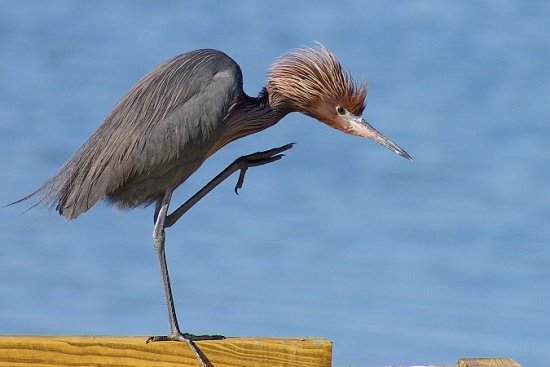- Egretta rufescens
Dichromanassa rufescens
Identification
Length: 30" (76cm). Wingspan: 46" (117cm), Weight: 1lb (450gm). A large wading bird with long, flexible neck and long legs characteristic of the family. Most birds are the dark morph, and are easy to identify with their reddish heads and fronts, and reddish-gray rear half. The Pacific coast subspecies has paler head and neck than eastern birds. In the Gulf of Mexico there is a small population (no more than 7%) of the white morph. It can be difficult to distinguish from other egrets: note the completely dark legs, dark lores, and long dark heavy bill.
Distribution
North America, Central America, and northern South America as well as in the Caribbean.
In North America breeds on the Gulf Coast of the USA, Mexico and on the Pacific Coast of Mexico; outside breeding season spreads to California (where it may also breed) as well as north along the Atlantic coast.
In Central America is found in summer along the coast of Yucatan in Mexico and Honduras and on the Pacific coast down to Costa Rica. More widespread outside of breeding season.
In northern South America is found on the caribbean coast of Colombia and Venezuela.
In the Caribbean, it is expected to be breeding in Bahamas and Cuba, with recent summer records also from Hispaniola and Puerto Rico. Extirpated as breeding bird in Jamaica, but occurs there outside of breeding season.
Vagrant in Panama.
Taxonomy
Two subspecies are recognized:[1]
- E.r. rufescens - Gulf Coast of US, West Indies, winters to northwest South America.
- E.r. dickeyi - southern half of Baja California, wintering into Guatemala and El Salvador.
Habitat
Mainly coastal, found on tidal mudflats and estuaries, rarely inland.
Behaviour
It nests on coastal islands.
Forages in shallow coastal areas and estuaries for fish. Usually solitary, it moves quickly compared to other wading birds. It often holds wings open when feeding, presumably to cast shadow and thereby easier see the fish below.
References
- Clements, JF. 2007. The Clements Checklist of Birds of the World. 6th ed. Ithaca: Cornell Univ. Press. ISBN 978-0801445019
Recommended Citation
- BirdForum Opus contributors. (2024) Reddish Egret. In: BirdForum, the forum for wild birds and birding. Retrieved 23 June 2024 from https://www.birdforum.net/opus/Reddish_Egret





